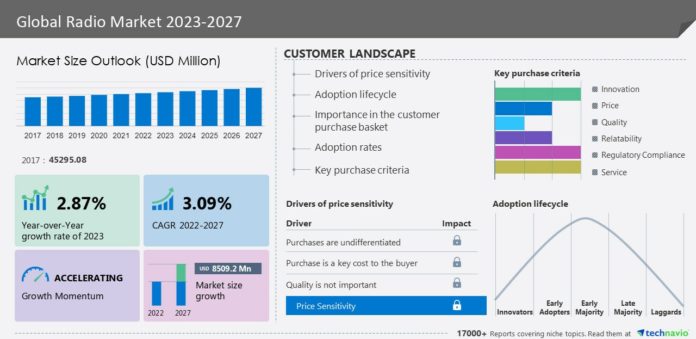The radio market is to grow by USD 8,509.2 million from 2022 to 2027 progressing at a CAGR of 3.09% during the forecast period. The report offers an up-to-date analysis regarding the current global market scenario, the latest trends and drivers, and the overall market environment. The market is driven by access to the latest music and live updates. Access to the latest music and live updates is a key factor driving market growth. The cost of subscribing to most radio channels is very low and the cost of the equipment is the only cost incurred by the radio, which must be adjusted. In addition, live broadcasts via radio channels include live coverage of sports, politics, regional news, local news, new product launches, traffic updates, date, and time savings, offers, etc. Listeners are updated without having to connect to any of their devices or the internet with these live updates on radio broadcasts. Hence, these factors are expected to drive market growth during the forecast period. –Here is an Exclusive report talking about Market scenarios with a historical period (2017-2021) and a forecast period (2023-2027). Download Sample Report in minutes!
The report on the radio market provides a holistic update, market size and forecast, trends, growth drivers, and challenges, as well as vendor analysis.
Radio Market 2023-2027 – Market Dynamics
Major Trends
Online radio services are a major trend in the market. Online radio streaming is getting popularity among listeners as a platform for listening to radio. The vendors in today’s market provide their services over the Internet. Moreover, several radio channels have merged with streaming portals and other radio channels to serve both online radio and music streaming services on the same platform. The demand for internet radio is increasing due to the availability of mobile internet and increasing internet penetration. Thus, online radio services are expected to drive market growth during the forecast period.
Significant Challenges
The lower impact of radio-based advertising is a significant challenge restricting market growth. The main source of revenue for the radio market is advertising. However, radio has a limited reach and limitations associated with it compared to other advertising mediums. Radio was originally a local media platform restricted to small areas of the country. Moreover, radio ads can become attractive with the help of a jingle, other tests like graphics are not possible in this form of advertising as they are only sound. Hence, the lower impact of radio-based advertising is expected to restrict market growth during the forecast period.
Radio Market 2023-2027: Market Segmentation
The radio market is segmented by type (broadcast radio, online mobile radio, and satellite radio), revenue (advertising, public license fee, and subscription), and geography( North America, Europe, APAC, South America, and the Middle East and Africa).
- The market share growth by the broadcast radio segment will be significant during the forecast period. The signal is transmitted from the radio station to the audience through a repeater station or directly through the broadcast station. Radio has types like amplitude modulation (AM) and frequency modulation (FM). The main driver of this segment is that it doesn’t require any special equipment to connect. Most smartphone manufacturers have integrated broadcast radio chips into their smartphones, enabling radio transmission to smartphones due to the latest advancements in technology. Hence, these factors are expected to drive market growth during the forecast period.
- North America is estimated to contribute 30% to the growth of the global market during the forecast period. The growth in the region is due to the rising number of advertisements and subscription revenue from Canada’s satellite radio. The US is the key contributor to the market in the region. Furthermore, the demand for digital radios is increasing due to the transition to using digital rather than analog standards in this region. Hence, these factors are expected to drive market growth in the region during the forecast period.







